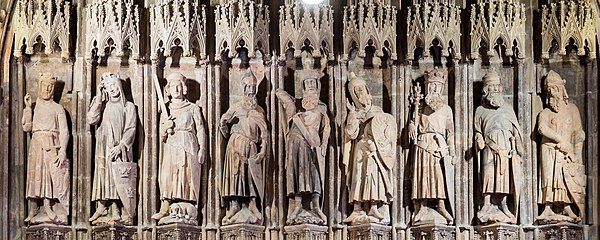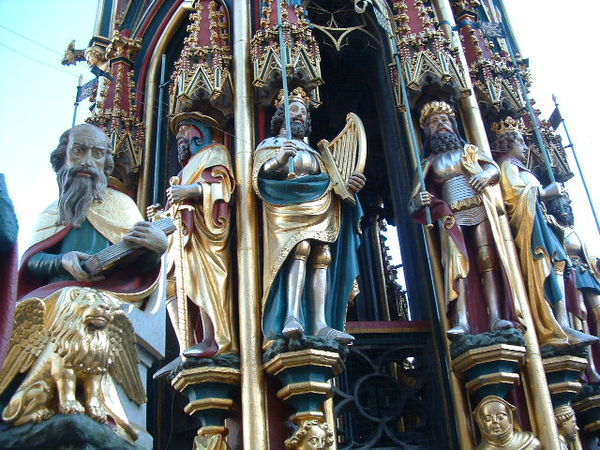Nine Worthies
Videos
Page
The Nine Worthies are nine historical, scriptural, and legendary men of distinction who personify the ideals of chivalry established in the Middle Ages, whose lives were deemed a valuable study for aspirants to chivalric status. All were commonly referred to as 'Princes', regardless of their historical titles. In French they are called Les Neuf Preux or "Nine Valiants", giving a more specific idea of the moral virtues they exemplified: those of soldierly courage and generalship. In Italy they are known as i Nove Prodi.

The 14th-century carving "Nine Good Heroes" (known as "Neun Gute Helden" in the original German) at City Hall in Cologne, Germany, is the earliest known representation of the Nine Worthies. From left to right are the three Christians: Charlemagne bearing an eagle upon his shield, King Arthur displaying three crowns, and Godfrey of Bouillon with a dog lying before him; then the three pagans: Julius Caesar, Hector, and Alexander the Great bearing a griffon upon his shield; and finally the three Jews: David holding a sceptre, Joshua, and Judah Maccabee.

Statues of the Nine Worthies on the Schöne Brunnen (beautiful fountain) in Nuremberg (1385–1396). Visible on the fountain, from left to right are: Judah Maccabee, David (with harp), Julius Caesar, Alexander. The figure in the left foreground, St Mark, with his lion, is part of another group

David, in Livro do Armeiro-Mor (fl 1v), a Portuguese armorial from 1509. The book opens with ten full-page illustrations of the Nine Worthies and Bertrand du Guesclin.

Lucas van Leyden's depiction of the three Old Testament kings as exotic contemporaries, in an engraving of c. 1520 depicting the Worthies in three sections
Chivalry
Videos
Page
Chivalry, or the chivalric language, is an informal and varying code of conduct developed in Europe between 1170 and 1220. It is associated with the medieval Christian institution of knighthood, with knights being members of various chivalric orders; knights' and gentlemen's behaviours were governed by chivalrous social codes. The ideals of chivalry were popularized in medieval literature, particularly the literary cycles known as the Matter of France, relating to the legendary companions of Charlemagne and his men-at-arms, the paladins, and the Matter of Britain, informed by Geoffrey of Monmouth's Historia Regum Britanniae, written in the 1130s, which popularized the legend of King Arthur and his knights of the Round Table.

Konrad von Limpurg as a knight being armed by his lady in the Codex Manesse (early 14th century)

God Speed by English artist Edmund Leighton, 1900: depicting an armoured knight departing for war and leaving his beloved

Reconstruction of a Roman cavalryman (eques)

Knights of Christ by Jan van Eyck